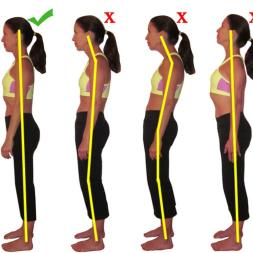
Postural defects at students - their identification and correction
In today's culture, everyone seems to be constantly connected to a device, whether it's a computer, laptop, tablet, or smartphone. Neglected postures such as rounding the back during long periods of time in front of the computer, sleeping improper posture and poor lifting of objects can lead to chronic back pain.
Description
Maintaining the natural lumbar curve of the back is essential in preventing posture-related back pain. This natural curvature acts as a shock absorber, helping to distribute weight along the length of the spine. Inevitably, a sedentary lifestyle results in thousands of hours spent with your body resembling a human question mark, head protruding, shoulders rounded. Early education of students about the correct postures is mandatory in order to have healthy individuals. In order to achieve our goals, we need perseverance, creativity and effective collaboration with students, parents and teachers. Right from the start school we should be concerned with the positions adopted by the students and their lifestyles. Through this project, we try to get the children to adopt correct positions on a daily basis, which will make life easier further. A life without pain is a life of good quality. Movement is known to have other important benefits for the body as well benefits such as better concentration, better coordination of movements, improvement memory and school performance. What are postural defects? Postural defects are deviations or deviations from a correct alignment of the segments body during daily activities. These behaviors can have a negative impact on the health of the spine, joints and muscles, contributing to problems pain and discomfort. One of the most common posture defects is the hunchback, o condition in which the spine bends excessively in the area of the shoulders and upper back, which which can lead to breathing problems and pain. Another common example is shoulder position forward, also known as "dropped shoulders", which can cause tension in the neck area and shoulders, as well as a decrease in flexibility. Adopting a healthy lifestyle would be the first step for our health. But the concept of a healthy lifestyle is a complex one and requires a concentration of our efforts on overcoming harmful habits.
Learning objectives
Posture Education: Educate students about the importance of maintaining the natural lumbar curve of the spine and the impact of correct posture on preventing back pain.
Early Intervention: Implement early intervention strategies to instill correct posture habits in students, emphasizing the significance of a healthy lifestyle.
Collaborative Approach: Foster collaboration among students, parents, and teachers to collectively work towards the goal of promoting healthy posture habits.
Daily Posture Habits: Encourage children to adopt daily correct postures to enhance their overall well-being and reduce the risk of future pain and discomfort.
Holistic Benefits of Movement: Emphasize the broader benefits of movement, including improved concentration, better coordination, enhanced memory, and overall academic performance.
Identification of Postural Vices: Provide insights into common postural vices, such as hunching and forward shoulder posture, and educate on their potential health implications.
Healthy Lifestyle Promotion: Introduce the concept of a healthy lifestyle, addressing issues like unhealthy eating, lack of movement, and poor posture during daily activities.
Addressing Apathy: Tackle apathy towards physical education classes, especially after extended periods of online learning, by highlighting the connection between physical activity, posture, and overall well-being.
Long-Term Health: Stress the long-term consequences of poor posture and lack of physical activity, emphasizing the importance of a proactive approach to health.
Practical Strategies: Equip participants with practical strategies to overcome detrimental habits, fostering a positive and sustainable impact on their health.
By addressing these objectives, the course aims to empower students with the knowledge and habits necessary for a lifetime of good posture and overall health.
Methodology & assessment
Practical Demonstrations: Incorporate practical demonstrations of correct posture and movement, allowing students to observe and replicate proper techniques.
Guest Speakers: Invite guest speakers, such as healthcare professionals or fitness experts, to provide expert insights and practical tips on maintaining a healthy lifestyle and posture.
Group Activities: Organize group activities, discussions, and role-playing exercises to encourage collaboration and reinforce the concepts learned.
Technology Integration: Utilize technology, such as videos and interactive apps, to enhance the learning experience and provide visual examples of correct posture.
Case Studies: Present real-life case studies highlighting the impact of posture on health, encouraging critical thinking and problem-solving skills.
Assessment:
Posture Observations: Conduct regular posture observations to assess students' progress in adopting correct postures during various activities.
Practical Assessments: Evaluate students through practical assessments, where they demonstrate proper posture in different scenarios.
Written Assignments: Assign written tasks requiring students to research and reflect on the importance of posture, contributing to their theoretical understanding.
Collaborative Projects: Assess collaborative projects that involve students working together to create awareness campaigns or presentations on posture and its benefits.
Class Participation: Evaluate class participation, considering engagement in discussions, workshops, and group activities related to posture education.
We are always ready to help you with information about accommodation, transport and anything else you need.
Certification details
Course participants will receive a certificate of attendence as well as an Erasmus + mobility certificate.
Pricing, packages and other information
-
Price:580Euro
Additional information
-
Language:English
-
Target audience ISCED:Early childhood education (ISCED 0)Primary education (ISCED 1)Lower secondary education (ISCED 2)
-
Target audience type:TeacherStudent TeacherTeacher Educator
-
Learning time:25 hours or more

